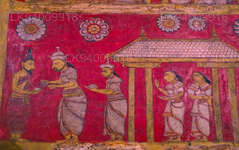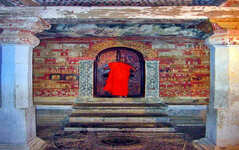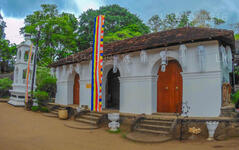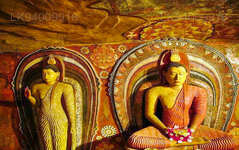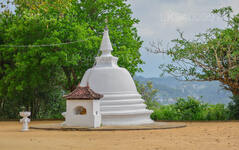
Ciudad de Kandy
Kandy, una pintoresca ciudad en el centro de Sri Lanka, es famosa por su rico patrimonio cultural, sus vibrantes festivales y su belleza paisajística. Enclavada entre exuberantes colinas, alberga el Templo de la Reliquia del Diente, declarado Patrimonio de la Humanidad por la UNESCO, y ofrece una cautivadora combinación de historia y esplendor natural.
Degaldoruwa Raja Maha Vihara
Amongst the rocky slopes and green valleys of rural Kandy lies a hidden treasure; the Degaldoruwa Raja Maha Vihara. This temple awes those who view it with its incredible Kandyan era frescoes. Construction of the temple began in the late 1770s under the reign of King Kirti Sri Rajasinha and was completed under the reign of his brother Rajadhi Rajasinha years later.
Legend
According to folklore a farmer was exploring the area and found a crevice between two rocks. On venturing into space he found a cave with a pile of golden sickles. The farmer was delighted with his discovery but feared retribution from some strange power. So he simply took only one sickle every morning and, after using it in his fields, returned it in the evening. His fields yielded an extremely healthy harvest and the farmer attributed it to the golden sickle. But then he became greedy. After all, he had been taking the sickles every day and there had been no ill effects, and there was a whole pile of them. So on the very last day of the harvest, he took two sickles instead of one and did not return one of them.
But unknown to the farmer, there had indeed been a guardian for the treasure. The guardian noticed the farmer taking the sickles, but kept quiet as he always returned them. On the day that the farmer took one sickle for himself, the guardian saw it at once and confronted him in his home. The terrified farmer immediately rushed to the crevice and returned the golden sickle that he had stolen. The guardian, who had been disappointed, then sealed the crevice by fusing the two rocks together. However, the villagers got to know this story and informed the king, Kirti Sri Rajasinha; who then ordered that the cave be found and a temple erected in it.
The Structure
- The temple is hollowed out of a 40 foot rock outcrop extending a natural cave. It consists of an elegant rock shelter with two roofed antechambers in front; a drummers’ hall and an image house; and the main shrine room cut into the rock itself. The two antechambers are constructed outside the rock outcrop and have wooden roofs.
- The architecture is unusual for the period as the drummers’ hall is not usually attached to the main temple.
- The image house is located through a set of old wooden doors, situated under a carved wooden Dragon Arch. It preserves a moonstone and a sequence of elaborate and colorful paintings showing scenes from four Jātaka tales, which tell the stories of the previous lives of Buddha.
- The door of the shrine room is banded with metal and once had jewels embedded within it. The inner walls of the shrine are completely covered in paintings; including the door.
- In addition to this main structure, there is a bo tree and a stupa on a plateau on the summit of the rocky outcrop above the temple. They can be reached by stairs carved into the temple.
The Frescoes
The paintings of Degaldoruwa, which are supposed to be some of the best of the Kandyan era, are believed to be the work of four ‘Sittara’ artists. The finest of these paintings grace the ceiling of the temple; ‘Mara Yudde’, an artistic depiction of Buddha’s internal spiritual battle against Māra, the demon of death, rebirth, and desire.
The murals are unique in that all the elements; the people, the trees and the animals; are a uniform size and only the front views of ]people are shown. The trees have a stylized form, with their branches and leave spreading out to either side. The individual elements, such as the adornments on the elephants and the uniforms of the attendants, are portrayed in great detail. All of the colors used by the artists in the murals were created from the barks
Acerca del distrito de Kandy
El distrito de Kandy está situado en la provincia central de Sri Lanka. Kandy, uno de los siete sitios declarados Patrimonio de la Humanidad en Sri Lanka, fue en el siglo XVI el hogar de los antiguos reyes kandyanos y una fuente de toda la música, las artes, la artesanía y la cultura del país. A unos 129 km de Colombo, Kandy está enclavada en un terreno montañoso y todas las miradas se dirigen al centro de la ciudad, donde el lago Kandy forma un elemento encantador. Kandy conserva un gran significado religioso para Sri Lanka, ya que en esta encantadora ciudad se encuentra el Dalada Maligawa o "Templo del Diente", en cuyo interior se encuentra bien custodiada la reliquia sagrada del diente de Buda.
El Real Jardín Botánico de Peradeniya se encuentra a unos 5 km al oeste del centro de la ciudad y recibe la visita de 1,2 millones de personas al año. Es el jardín botánico más grande de la isla. El Udawatta Kele (Bosque Udawatta) es un santuario protegido situado en el corazón de la ciudad, justo al norte del Templo del Diente.
Kandy es una ciudad de mayoría cingalesa; existen importantes comunidades pertenecientes a otros grupos étnicos, como moros y tamiles. Kandy ocupa el segundo lugar, después de Colombo, como centro de la economía de Sri Lanka. Muchas grandes empresas tienen grandes sucursales en Kandy, y numerosas industrias, como la textil, la del mueble, la informática y la joyería, se encuentran aquí. Numerosos centros de investigación agrícola se encuentran en la ciudad.
Y fuente de toda la música, las artes, la artesanía y la cultura del país. A unos 129 km de Colombo, Kandy se encuentra enclavada en un terreno montañoso y todas las miradas se dirigen al centro de la ciudad, donde el lago Kandy forma un encantador paisaje. Kandy conserva una gran importancia religiosa para Sri Lanka, ya que en esta encantadora ciudad se encuentra el Dalada Maligawa o Templo del Diente, donde se custodia la reliquia sagrada del diente de Buda.
Acerca de la Provincia Central
La Provincia Central de Sri Lanka se compone principalmente de terreno montañoso. Tiene una superficie de 5.674 km² y una población de 2.421.148 habitantes. Algunas de sus ciudades principales son Kandy, Gampola (24.730), Nuwara Eliya y Bandarawela. La población es una mezcla de cingaleses, tamiles y moros.
Tanto Kandy, la capital de la montaña, como Nuwara Eliya se encuentran en la Provincia Central, al igual que Sri Pada. La provincia produce gran parte del famoso té de Ceilán, plantado por los británicos en la década de 1860 tras una devastadora enfermedad que destruyó todas las plantaciones de café de la provincia. La Provincia Central atrae a numerosos turistas, con pueblos en las colinas como Kandy, Gampola, Hatton y Nuwara Eliya. El Templo del Diente o Dalada Maligawa es el principal lugar sagrado de la provincia Central.
Tanto Kandy, la capital de la montaña, como Nuwara Eliya se encuentran en la Provincia Central, al igual que Sri Pada. La provincia produce gran parte del famoso té de Ceilán, plantado por los británicos en la década de 1860 tras una devastadora enfermedad que destruyó todas las plantaciones de café de la provincia. La Provincia Central atrae a numerosos turistas, con pueblos en las colinas como Kandy, Gampola, Hatton y Nuwara Eliya. El Templo del Diente o Dalada Maligawa es el principal lugar sagrado de la provincia Central.


